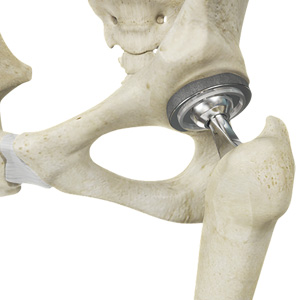
Total Hip Replacement Procedure
Hip joint replacement surgery is one of the most successful pain-relieving operations for the treatment of disabling hip arthritis in the United States today, with almost 300,000 procedures performed annually. By replacing the diseased hip joint with an artificial joint, hip replacement surgery can relieve pain, increase motion and help you get back to enjoying normal, everyday activities.
Since the inception of this surgery over 40 years ago, there have been numerous advances made to create more minimally invasive techniques. Early prostheses were made of metal and plastic and were “glued” in place. Today cementless prostheses are utilized which eliminate the glue and allow the bone to adhere directly to the prosthesis (bone ingrowth). Alternative materials includuing advanced plastics, metal alloys, or ceramic implants may provide greater longevity for arthritis surgery patients.
Surgical Procedure:
In a hip replacement procedure, Dr. LaReau removes damaged cartilage and bone from the hip and then positions new joint surfaces to restore the alignment and function of the hip. The normal hip joint is a ball and socket joint. The socket is a “cup-shaped” bone of the pelvis called the acetabulum. The ball is the head of the thigh-bone (femur). During a hip joint replacement procedure, Dr. LaReau removes the diseased ball and socket, replaces them with parts composed of metal and plastic. A hip joint replacement may take 1-2 hours of surgical time with a few additional hours of preparation prior to surgery.
Recovery:
Physical therapy is extremely important in the overall outcome of any joint replacement surgery. It helps to prevent scarring of tissue around the joint (contractures) and aides in strengthening the muscles around the hip joint.
In most cases physical therapy begins on the first day after surgery with minor movements done from a seated position. Eventually, rehabilitation incorporates stepping, walking and climbing. For some surgical approaches, specific techniques of body posturing, sitting and using an elevated toilet seat are extremely helpful. Occupational therapists are also part of the rehabilitation process. They often help to educate the patient about the adaptive equipment that is available to them and provide instruction for activities of daily living (ADL’s). Most patients attend outpatient physical therapy for a period of time while incorporating home exercises into their routines.
Initially, supportive devices such as walker or crutches are used and pain is monitored while exercise takes place. Some degree of discomfort is normal, however many patient notice — even early on — substantial relief from their preoperative levels of pain.
Who is a candidate?
Hip joint replacement is an elective procedure, which means that it is an option selected among other alternatives, and performed on a non-emergent basis. The most common condition that results in the need for hip replacement is osteoarthritis, a degenerative arthritis that is generally seen with aging. Congenital abnormalities of the hip joint or prior trauma to the hip joint can also contribute to degenerative disease.
Hip replacement is generally considered after pain becomes so severe that it impedes normal function despite the use of medications. The progressively intense chronic pain together with impairment of walking, climbing stairs and even rising from a sitting position, eventually become reasons to consider a total hip replacement.
Hip conditions, which can be treated with hip replacement, include:
- Arthritis
- Avascular necrosis
- Fracture
- Autoimmune diseases such as Systemic Lupus and Rheumatoid Arthritis
Click here to read more about Total Hip Replacement from the American Academy of Orthopaedic Surgeons.






